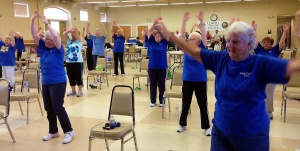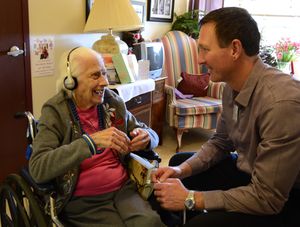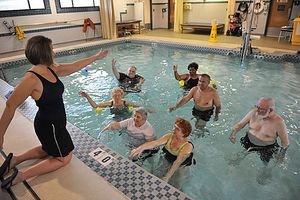Physical Activity in Older Adults
Original Editor - Caroline Greenwood
Top Contributors - Kim Jackson, Wendy Walker, Admin, Vidya Acharya, Giulia Neculaes, Bhanu Ramaswamy, Lucinda hampton, Evan Thomas, Simisola Ajeyalemi, Christina Nowak, Shaimaa Eldib, Rucha Gadgil and Carina Therese Magtibay
Introduction[edit | edit source]
Physical activity (PA) in older people is critically important in the prevention of disease, maintenance of independence and improvement of quality of life.
- Regular physical activity (PA) can bring significant health benefits to people of all ages and the need for PA does not end in later life with evidence increasingly indicating that PA can extend years of active independent living, reduce disability and improve the quality of life for older people
- Dramatic global population ageing has brought new demands to improve older people’s health by adding “quality” to their extended lives[1] and increasing physical activity is one way to bring this about.
What is Ageing?[edit | edit source]
Ageing is both biological and psychosocial changes.
- Psychosocial changes occur as a person’s role in society evolves, and they often also adapt their goals and motivational priorities.
- Biologically changes occur - molecular and cellular damage occurs which leads to a decrease in physiological reserve and increased risk of many diseases. Even in healthy and active people; strength, endurance, bone density and flexibility all decline at a rate of approximately 10% per decade. Muscle power is lost faster, at a rate of about 30% per decade[2]. This can lead to a decrease in a person’s level of function.
A recent study examining 1-year changes in the physical functioning of older people using the International Classification of Functioning, Disability and Health (ICF) framework suggested a significant decrease in muscle strength (both hip abductors and knee extensors) walking capacity, speed, mobility, sit-to-stand performance, upper extremity function, and balance performance at the end of 1 year. Although there were no significant changes seen in the levels of participation in activities of daily living, activities related to balance, or physical activity[3].
We live in an ageing population with the majority of people now are expected to live beyond 60 years.
- In 2015, 8.3% of the world’s population was older than 65, an increase of 1% from 2005[4].
- This population is often seen as having poor health, this doesn’t need to be the case.
- Many chronic conditions and non-communicable diseases can be prevented or delayed, by engaging in healthy behaviours.
- Despite this, studies have found that this age group spend on average 10.7 hours per day sitting, with 40% of this age group living a sedentary lifestyle[5].
- It is crucial that this is addressed, and that older adults are encouraged to be more active.
Benefits of Exercise[edit | edit source]
As is commonly known, there are many health benefits of exercise and this stands true for adults of all ages. Systematic review and meta-analyses among Japanese community-dwelling older adults suggest the prevalence of sarcopenia (9.9% overall: 9.8% among men, and 10.1% among women), providing valuable information in addressing sarcopenia prevention in the older community[6].
Resistance training will improve strength and can reverse or delay the decline of muscle mass and strength that occurs with ageing. Aerobic exercise can help to improve endurance by increasing the capillary density, mitochondrial and enzyme levels in the skeletal muscles. Together, this can help older adults to maintain their participation in ADLs and therefore maintain independence[7]. Randomized Controlled trial demonstrated that Augmented Prescribed Exercise Program (APEP) enhances outcomes in weak older medical patients in the acute setting as compared to the usual care, thus suggesting that this intervention is valuable to frail medical inpatients[8].
Exercise can also help to reduce the risk of many non-communicable diseases. Exercise has been shown to:
- Reduce the risk of coronary heart disease, stroke, certain types of cancers and diabetes.
- Prevent post-menopausal osteoporosis and therefore reduce the risk of osteoporotic fractures.
- Reduce the complications of immobility
- Reduce the risk of accidental falls
- Improve mental/cognitive function, reduces stress/anxiety and improve self- confidence[9]
Being active from an early age can help prevent many diseases just as regular movement and activity can help relieve the disability and pain associated with these conditions. Importantly, the benefits of physical activity can be enjoyed even if regular practice starts late in life. It has been suggested that older adults engaged in regular physical activity demonstrate improved:
- Balance
- Strength
- Coordination and motor control
- Flexibility
- Endurance.
What Exercise is Appropriate for Older Adults?[edit | edit source]
The type of exercise and intensity will depend upon the ability of the person. Physical activity for older adults can take many forms (e.g. walking, swimming, stretching, dancing, gardening, hiking, cycling or organised exercise sessions). However, there are several important considerations specific to the older adult population with regard to physical activity recommendations:
- The intensity of aerobic activity takes into account the older adult's aerobic fitness.
- Activities that maintain or increase flexibility are recommended.
- Balance exercises are recommended for older adults at risk of falls.
- Older adults that have medical conditions or disabilities that may affect their capacity to be physically active should seek advice from a doctor.
Clinical Guidelines[edit | edit source]
The current international recommendations for adults for physical activity include:
- Australia- Everyone should try to do at least 30 minutes of moderate-intensity physical activity on most days of the week[10].
- Canada- Put together at least 30 minutes of moderate-intensity physical activity on most preferably all days[11].
- America- All adults should accumulate a minimum of 30 minutes of at least moderate-intensity physical activity on most, if not all days of the week[12].
- United Kingdom- For general health benefit, adults should achieve a total of at least 30 minutes a day of at least moderate-intensity physical activity on five or more days of the week[13]
Falls Prevention[edit | edit source]
Every year approximately 30% of adults older than 65 experience at least one fall. Exercise has been shown to be effective in reducing the number of falls and the number of injuries from falls. This exercise can be either home or centre-based, group or individual; but must involve a mix of balance, gait training and strength training[14]. Exercise must be challenging but safe. This can be achieved by reducing the participant’s base of support, getting them to move their centre of gravity or by removing their hand support. Ideally, at least 3 hours of exercise must be completed each week for the greatest reduction in risk of falls[15].
Physical Activity in Dementia[edit | edit source]
- Studies[16][17] show that patients with dementia or mild cognitive impairments have better cognitive scores after 6 to 12 months of
exercise compared with sedentary controls.
- Meta-analyses of RCTs of aerobic exercise in healthy adults were also associated with significantly improved cognitive scores[18], concluding " physical exercise may also attenuate cognitive decline via mitigation of cerebrovascular risk, including the contribution of small vessel disease to dementia".
- A conflicting study (2018) came to a different conclusion. A large, multi-centre RCT studied 494 people with dementia, with a 2:1 random allocation to exercise versus control. This Dementia and Physical Activity [DAPA] trial found that "the mean score on the Alzheimer's Disease Assessment Scale-Cognitive Subscale (ADAS-cog) worsened more for people with dementia who were assigned to a year of vigorous exercise than for people who kept to their usual routines.[19]"The study states "A four-month aerobic and strengthening exercise programme of moderate to high intensity added to usual care does not slow cognitive decline in people with mild to moderate dementia. The exercise improved physical fitness in the short term, but this did not translate into improvements in activities of daily living, behavioural outcomes, or health-related quality of life. There is the possibility that the intervention could worsen cognition."
- A randomized control trial suggests home-based exercise and nutrition strategies have a positive outcome on the frailty score and physical performance in the pre-frail or frail older adults.[20]
- Another single-blind randomized clinical trial evaluating the effects of usual care and early structured exercise intervention on 370 elderly hospitalized patients showed improvement in muscle power output of lower limbs at submaximal loads and maximal muscle strength[21].
- A systematic review shows the advantages of brain health with exercise training in older adults due to the changes in brain structure and function.[22]
- Systematic review suggests e-health strategies are effective in enhancing Physical Activity in older patients[23].
Designing an Exercise Program[edit | edit source]
WHO has published specific guidelines (2020) for people older than 65 and recommended that both aerobic exercise and strength training should be carried out.
- Adults and older adults (>65) should do at least 150–300 min of moderate-intensity aerobic physical activity, or at least 75–150 min of vigorous-intensity aerobic physical activity, or an equivalent combination of moderate-intensity and vigorous-intensity activity throughout the week for substantial health benefits;
- Adults and older adults (>65) should also do muscle-strengthening activities at moderate or greater intensity that involve all major muscle groups on 2 or more days a week, as these provide additional health benefits.
- Older adults, as part of their weekly physical activity, should do varied multicomponent physical activity that emphasises functional balance and strength training at moderate or greater intensity on 3 or more days a week, to enhance functional capacity and to prevent falls[24].
- Aerobic exercise- Older persons should build up to at least 30 minutes of aerobic exercise – for example walking, swimming, water exercises, and stationary cycling – on most, if not all, days. Studies show that a treadmill-walking program has positive effects on the postural balance of institutionalized older adults[25].
- Strength training- The following regimen allows the individual to maintain bone and muscle strength. In order to continue to strengthen muscle and bone, one should steadily increase the intensity (weight) of the workout. Recommendations are:
The exact exercise chosen will, of course, vary from person to person. It is important that medical conditions are considered, as well as the patients' fitness and level of function. If exercise is new to someone, it should be first discussed with their health care provider and then a program of gradual increase should be implemented. As recommended by WHO, exercise should include both aerobic and strength training, but it should also ideally include a component of balance training and flexibility work. Options may include hiking, walking, swimming, gym, dancing, tai chi, or chair exercises. It is important to find something that each person enjoys and can continue with independently[10].
A qualitative study exploring how older people participating in an evidence-based exercise intervention describing their relationship with their therapists and how this relationship might contribute to their motivation for exercise, suggests that 'Therapeutic Alliance' is an essential part of therapy and relational knowledge and competence are necessary for transferring professional knowledge in therapy. The findings are useful to therapists involved in clinical practice, especially to those working with vulnerable groups.
How to Promote Positive Health Message[edit | edit source]
The WHO 2020 guidelines reaffirm messages that some physical activity is better than none, that more physical activity is better for optimal health outcomes and recommend reducing sedentary behaviours[24].
In order to successfully engage older adults, it is important to frame the message in the correct way. It has been found that gain-framed messages, ie. Messages that highlight the benefits of engaging in a particular behaviour, are significantly more likely than loss-framed messages to promote prevention behaviour[27]. For example, the message ‘exercising regularly can help you to lose weight’ would be more effective than the message ‘not exercising regularly can make you gain weight'.
Links to healthy living campaigns:
- Make your move- sit less- be active for life
- Growing stronger- strength training for older adults
- Living Longer Living Stronger
Related pages[edit | edit source]
References[edit | edit source]
- ↑ Sun F, Norman IJ, While AE. Physical activity in older people: a systematic review. BMC public health. 2013 Dec;13(1):449. Available from:https://bmcpublichealth.biomedcentral.com/articles/10.1186/1471-2458-13-449 (last accessed 16.2.2020)
- ↑ Skelton D, Young A, Walker A, Hoinville E. Physical activity in later life:Further analysis of the Allied Dunbar National Fitness Survey and Health Education Authority National Survey of Activity and Health. London: Health Education Authority; 1999.
- ↑ Kahraman T, Çekok FK, Üğüt BO, Keskinoğlu P, Genç A. One-Year Change in the Physical Functioning of Older People According to the International Classification of Functioning Domains. Journal of geriatric physical therapy (2001). 2019 Mar.
- ↑ Population ages 65 and above [Internet]. The World Bank. 2016 [cited 23 May 2017]. Available from: http://data.worldbank.org/indicator/SP.POP.65UP.TO.ZS
- ↑ British Heart Foundation. Active for Later Life. London: BHF; 2007.
- ↑ MAKIZAKO H, NAKAI Y, TOMIOKA K, TANIGUCHI Y. Prevalence of sarcopenia defined using the Asia Working Group for Sarcopenia criteria in Japanese community-dwelling older adults: A systematic review and meta-analysis. Physical Therapy Research. 2019 Dec 20;22(2):53-7.
- ↑ Liu CJ, Latham NK. Progressive resistance strength training for improving physical function in older adults (review). Cochrane database of systematic reviews. 2009
- ↑ Chou CH, Hwang CL, Wu YT. Effect of exercise on physical function, daily living activities, and quality of life in the frail older adults: a meta-analysis. Archives of physical medicine and rehabilitation. 2012 Feb 1;93(2):237-44.
- ↑ Active aging in Victoria [Internet]. health.vic. 2017 [cited 23 May 2017]. Available from: https://www2.health.vic.gov.au/ageing-and-aged-care/wellbeing-and-participation/healthy-ageing/active-ageing
- ↑ 10.0 10.1 Australia's Physical Activity and Sedentary Behavior Guidelines [Internet]. The Department of Health. 2017 [cited 23 May 2017]. Available from: - http://www.health.gov.au/internet/main/publishing.nsf/Content/3244D38BBBEBD284CA257BF0001FA1A7/$File/choosehealth-brochure.pdfhttp://www.health.gov.au/internet/main/publishing.nsf/content/health-pubhlth-strateg-phys-act-guidelines#chba
- ↑ Canadian Society for Exercise Physiology. Older adults- 65 & older [Internet]. Canada; 2012 p. 1. Available from: http://www.csep.ca/CMFiles/Guidelines/CSEP_PAGuidelines_older-adults_en.pdf
- ↑ National Center for Chronic Disease Prevention and Health Promotion. How much physical activity do older adults need? [Internet]. Center for disease control and prevention. 2015 [cited 24 May 2017]. Available from: https://www.cdc.gov/physicalactivity/basics/older_adults/
- ↑ Department of Health. Physical activity guidelines for older adults [Internet]. National Health Service. 2011 [cited 24 May 2017]. Available from: https://www.nhs.uk/Livewell/fitness/Documents/older-adults-65-years.pdf
- ↑ Gillespie LD, Robertson MC, Gillespie WJ, Sherrington C, Gates S et al. Interventions for preventing falls in older people living in the community. Cochrane database of systematic reviews. 2012
- ↑ herrington C, Michaleff Z, Fairhall N, Paul S, Tiedemann A, Whitney J et al. Exercise to prevent falls in older adults: an updated systematic review and meta-analysis. British Journal of Sports Medicine [Internet]. 2016;. Available from: http://bjsm.bmj.com/content/early/2016/10/04/bjsports-2016-096547
- ↑ Groot C,Hooghiemstra AM,Raijmakers PG, et al The effect of physical activity on cognitive function in patients with dementia: A meta-analysis of randomized control trials. Ageing Res Rev2016;25:13-23
- ↑ Forbes D, Forbes SC, Blake CM, Thiessen EJ, Forbes S. Exercise programs for people with dementia. Cochrane Database Syst Rev2015;(4)
- ↑ Ahlskog JE, Geda YE, Graff-Radford NR, Petersen RC. Physical exercise as a preventive or disease-modifying treatment of dementia and brain aging. Mayo Clin Proc. 2011;86:876-884. doi:10.4065/mcp.2011.0252.
- ↑ Lamb S, Sheehan B, Atherton N, et al. Dementia And Physical Activity (DAPA) trial of moderate to high intensity exercise training for people with dementia: randomised controlled trial. BMJ. 2018;361:k1675
- ↑ Hsieh TJ, Su SC, Chen CW, Kang YW, Hu MH, Hsu LL, Wu SY, Chen L, Chang HY, Chuang SY, Pan WH. Individualized home-based exercise and nutrition interventions improve frailty in older adults: a randomized controlled trial. International Journal of Behavioral Nutrition and Physical Activity. 2019 Dec 1;16(1):119.
- ↑ Sáez de Asteasu ML, Martínez‐Velilla N, Zambom‐Ferraresi F, Ramírez‐Vélez R, García‐Hermoso A, Cadore EL, Casas‐Herrero Á, Galbete A, Izquierdo M. Changes in muscle power after usual care or early structured exercise intervention in acutely hospitalized older adults. Journal of Cachexia, Sarcopenia and Muscle. 2020 Mar 10.
- ↑ Lustig C, Shah P, Seidler R, Reuter-Lorenz PA. Aging, training, and the brain: a review and future directions. Neuropsychology review. 2009 Dec 1;19(4):504-22.
- ↑ Kwan RY, Salihu D, Lee PH, Tse M, Cheung DS, Roopsawang I, Choi KS. The effect of e-health interventions promoting physical activity in older people: a systematic review and meta-analysis. European Review of Aging and Physical Activity. 2020 Dec;17:1-7.
- ↑ 24.0 24.1 Bull FC, Al-Ansari SS, Biddle S, Borodulin K, Buman MP, Cardon G, Carty C, Chaput JP, Chastin S, Chou R, Dempsey PC. World Health Organization 2020 guidelines on physical activity and sedentary behaviour. British Journal of Sports Medicine. 2020 Dec 1;54(24):1451-62.Available from:https://bjsm.bmj.com/content/54/24/1451 (accessed 2.12.2020)
- ↑ Pereira NM, Araya MJ, Scheicher ME. Effectiveness of a treadmill training programme in improving the postural balance on institutionalized older adults. Journal of aging research. 2020;2020.
- ↑ Physical Activity and Older Adults [Internet]. World Health Organisation. 2017 [cited 23 May 2017]. Available from: http://www.who.int/dietphysicalactivity/factsheet_olderadults/en/
- ↑ Gallagher K, Updegraff J. Erratum to: Health Message Framing Effects on Attitudes, Intentions, and Behaviors: A Meta-analytic Review. Annals of Behavioral Medicine. 2013;46(1):127-127.









